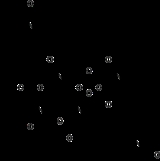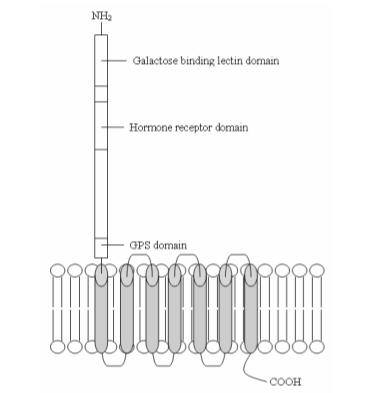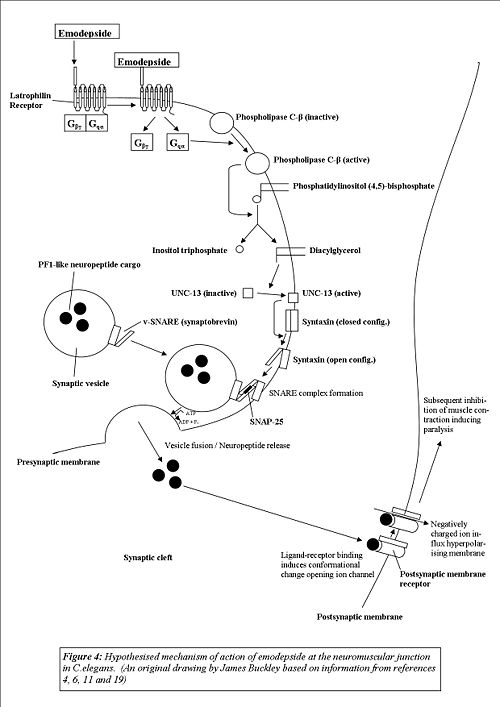
Emodepside
Encyclopedia
Emodepside is an anthelmintic
drug that is effective against a number of gastrointestinal nematode
s, is licensed for use in cat
s and belongs to the class of drugs known as the octadepsipeptides, a relatively new class of anthelmintic
(research into these compounds began in the early 1990s), which are suspected to achieve their anti-parasitic effect by a novel mechanism of action
due to their ability to kill nematodes resistant to other anthelmintics.
 Emodepside is synthesised by attaching a morpholine ring “at the paraposition of each of the two D-phenyllactic acids” to PF1022A, a metabolite
Emodepside is synthesised by attaching a morpholine ring “at the paraposition of each of the two D-phenyllactic acids” to PF1022A, a metabolite
of Mycelia sterile, a fungus
that inhabits the leaves of Camellia
japonica – a flowering shrub
.
in addition to having effects in other tissues such as the inhibition of egg laying.
venom that can cause paralysis
and subsequent death in nematodes and humans alike. LAT-1 (1014 amino acids, 113 KDa coded by the B0457.1 gene) and LAT-2 (1338 amino acids, 147 KDa coded by the B0286.2 gene) are located presynaptically at the neuromuscular junction
in Caenorhabditis elegans and share 21% amino acid identity with each other (the amino acid sequence homology LAT-1 shares with rat, bovine and human latrophilins has been shown to be 22, 23 and 21% respectively).
 Following receptor-ligand binding, a conformational change induced in the receptor activates the Gq protein, freeing the Gqα subunit from the βγ complex. The Gqα protein then goes on to couple-to and activate the signaling molecule phospholipase
Following receptor-ligand binding, a conformational change induced in the receptor activates the Gq protein, freeing the Gqα subunit from the βγ complex. The Gqα protein then goes on to couple-to and activate the signaling molecule phospholipase
-C-β, a protein that has been identified as being key to the modulation of regulatory pathways of vesicle release in C.elegans.
In its signaling cascade, PLC-β (like other phospholipases) hydrolyses phosphatidylinositolbisphosphate to yield inositol trisphosphate (IP3) and diacylglycerol
(DAG). As IP3 receptors have sparse or little distribution throughout the pharyngeal nervous system of C.elegans (one of the tissues where LAT-1 agonists such as α-LTX and emodepside have their most predominant effects) and β-phorbel esters (which mimic the effects of DAG) have been shown to have a stimulatory action on synaptic transmission, it has been concluded that it is the DAG component of the cascade that regulates neurotransmitter
release.
Indeed, in C.elegans DAG regulates UNC-13, a plasma-membrane associated protein critical for vesicle-mediated neurotransmitter release and mutational studies have shown that two UNC-13 reduction of function mutants show resistance to emodepside, observations supporting this hypothesized mechanism of action.
The mechanism by which activation of UNC-13 results in neurotransmitter
release (the ultimate result of latrophilin activation) is through interaction with the synaptosomal membrane protein syntaxin
, with UNC-13 binding to the N-terminus of syntaxin and promoting the switch from the closed form of syntaxin
(which is incompatible with SNARE complex synaptobrevin, SNAP-25
and syntaxin
formation) to its open formation so that SNARE complex formation can be achieved, thereby allowing vesicle
fusion and release to take place.
At a molecular level, the net result of the activation of this pathway, is the spontaneous stimulation of inhibitory PF1-like neuropeptide
release (this is suspected due to Emodepside’s inhibition of acetylcholine-elicited muscle contraction requiring both calcium ions and extracellular potassium ions, similar to the action of PF1/PF2). Although in experiments on synaptosomes, α-LTX triggered non-calcium dependent exocytosis of vesicles containing acetylcholine
, glutamate and GABA
, both glutamate and GABA
have been ruled out as the sole neurotransmitters responsible for emodepside’s action) which then acts on the post-synaptic membrane (i.e. the pharyngeal/muscle membrane) of the nematode, having an inhibitory effect thereby either inducing paralysis
or inhibiting pharyngeal pumping, both of which ultimately result in the death of the organism.
 Mutational studies involving LAT-1 knockout and LAT-2 gene deletion mutants have revealed that the role of latrophilin receptors in the different tissues that they are expressed differs between subtypes, with LAT-1 being expressed in the pharynx of C.elegans (thereby modulating pharyngeal pumping) and LAT-2 having a role in locomotion.
Mutational studies involving LAT-1 knockout and LAT-2 gene deletion mutants have revealed that the role of latrophilin receptors in the different tissues that they are expressed differs between subtypes, with LAT-1 being expressed in the pharynx of C.elegans (thereby modulating pharyngeal pumping) and LAT-2 having a role in locomotion.
In addition to exerting an effect on the nematode via binding to Latrophilin receptors, there is also recent evidence that indicates that emodepside also interacts with the BK potassium channel coded by the gene Slo-1. This protein (see figure for structure) is a member of the 6 transmembrane helix structural class of potassium ion channels with each subunit consisting of 6 transmembrane helices and 1 P domain (this P domain is conserved in all potassium ion channels and forms the selectivity filter that enables the channel to transport potassium ions across the membrane in great preference to other ions). These subunits group together to form high conductance BK-type channels that are gated by both membrane potential and intracellular calcium levels (this calcium ion sensing ability is accommodated by an intracellular tail region on Slo-like subunits that form a calcium ion binding motif consisting of a run of conserved aspartate residues, termed a “calcium bowl”), with their physiological role being to regulate the excitability of neurons and muscle fibres, through the way in which they participate in action potential repolariziation (with potassium ion efflux being used to repolarize the cell following depolarization).
The presumable effect that emodepside interaction with these channels would exert on the neuron would be to activate the channel causing potassium ion efflux, hyper-polarization and subsequent inhibition of excitatory neurotransmitter effect (acetylcholine if acting at the neuromuscular junction), having an inhibitory effect on synaptic transmission, the production of postsynaptic action potentials and ultimately muscle contraction (manifesting itself as paralysis or reduced pharyngeal pumping).
Which out of Latrophilin receptors and BK-potassium channels is emodepside’s primary site of action remains to be completely deduced. Both LAT-1/LAT-2 and slo-1 mutants (reduction/loss of function) show significant resistance to emodepside with it being conceivable that the presence of both is required for emodepside to induce its full effect.
) for topical application under the tradename Profender.
Anthelmintic
Anthelmintics or antihelminthics are drugs that expel parasitic worms from the body, by either stunning or killing them. They may also be called vermifuges or vermicides .-Pharmaceutical classes:...
drug that is effective against a number of gastrointestinal nematode
Nematode
The nematodes or roundworms are the most diverse phylum of pseudocoelomates, and one of the most diverse of all animals. Nematode species are very difficult to distinguish; over 28,000 have been described, of which over 16,000 are parasitic. It has been estimated that the total number of nematode...
s, is licensed for use in cat
Cat
The cat , also known as the domestic cat or housecat to distinguish it from other felids and felines, is a small, usually furry, domesticated, carnivorous mammal that is valued by humans for its companionship and for its ability to hunt vermin and household pests...
s and belongs to the class of drugs known as the octadepsipeptides, a relatively new class of anthelmintic
Anthelmintic
Anthelmintics or antihelminthics are drugs that expel parasitic worms from the body, by either stunning or killing them. They may also be called vermifuges or vermicides .-Pharmaceutical classes:...
(research into these compounds began in the early 1990s), which are suspected to achieve their anti-parasitic effect by a novel mechanism of action
Mechanism of action
In pharmacology, the term mechanism of action refers to the specific biochemical interaction through which a drug substance produces its pharmacological effect...
due to their ability to kill nematodes resistant to other anthelmintics.
Synthesis

Metabolite
Metabolites are the intermediates and products of metabolism. The term metabolite is usually restricted to small molecules. A primary metabolite is directly involved in normal growth, development, and reproduction. Alcohol is an example of a primary metabolite produced in large-scale by industrial...
of Mycelia sterile, a fungus
Fungus
A fungus is a member of a large group of eukaryotic organisms that includes microorganisms such as yeasts and molds , as well as the more familiar mushrooms. These organisms are classified as a kingdom, Fungi, which is separate from plants, animals, and bacteria...
that inhabits the leaves of Camellia
Camellia
Camellia, the camellias, is a genus of flowering plants in the family Theaceae. They are found in eastern and southern Asia, from the Himalaya east to Korea and Indonesia. There are 100–250 described species, with some controversy over the exact number...
japonica – a flowering shrub
Shrub
A shrub or bush is distinguished from a tree by its multiple stems and shorter height, usually under 5–6 m tall. A large number of plants may become either shrubs or trees, depending on the growing conditions they experience...
.
Anthelmintic effects
When applied to nematodes, emodepside has been shown to have a range of effects, inhibiting muscle in the parasitic nematode Ascaris sum and inhibiting locomotive and pharyngeal movement in Caenorhabditis elegansCaenorhabditis elegans
Caenorhabditis elegans is a free-living, transparent nematode , about 1 mm in length, which lives in temperate soil environments. Research into the molecular and developmental biology of C. elegans was begun in 1974 by Sydney Brenner and it has since been used extensively as a model...
in addition to having effects in other tissues such as the inhibition of egg laying.
Mechanism of action
One of the ways in which this drug achieves its effects has been shown to be through binding to a group of G-protein coupled receptors called latrophilins, first identified as being target proteins for α-latrotoxin (the other target protein of α-LTX being neurexin, a membrane receptor with laminin-like extracellular domains), a component of black widow spiderBlack widow spider
Latrodectus mactans, the Southern black widow, is a highly venomous species of spider in the genus Latrodectus. They are well known for the distinctive black and red coloring of the female of the species and for the fact that she will occasionally eat her mate after reproduction. The species is...
venom that can cause paralysis
Paralysis
Paralysis is loss of muscle function for one or more muscles. Paralysis can be accompanied by a loss of feeling in the affected area if there is sensory damage as well as motor. A study conducted by the Christopher & Dana Reeve Foundation, suggests that about 1 in 50 people have been diagnosed...
and subsequent death in nematodes and humans alike. LAT-1 (1014 amino acids, 113 KDa coded by the B0457.1 gene) and LAT-2 (1338 amino acids, 147 KDa coded by the B0286.2 gene) are located presynaptically at the neuromuscular junction
Neuromuscular junction
A neuromuscular junction is the synapse or junction of the axon terminal of a motor neuron with the motor end plate, the highly-excitable region of muscle fiber plasma membrane responsible for initiation of action potentials across the muscle's surface, ultimately causing the muscle to contract...
in Caenorhabditis elegans and share 21% amino acid identity with each other (the amino acid sequence homology LAT-1 shares with rat, bovine and human latrophilins has been shown to be 22, 23 and 21% respectively).

Phospholipase
A phospholipase is an enzyme that hydrolyzes phospholipids into fatty acids and other lipophilic substances. There are four major classes, termed A, B, C and D, distinguished by the type of reaction which they catalyze:*Phospholipase A...
-C-β, a protein that has been identified as being key to the modulation of regulatory pathways of vesicle release in C.elegans.
In its signaling cascade, PLC-β (like other phospholipases) hydrolyses phosphatidylinositolbisphosphate to yield inositol trisphosphate (IP3) and diacylglycerol
Diglyceride
A diglyceride, or a diacylglycerol , is a glyceride consisting of two fatty acid chains covalently bonded to a glycerol molecule through ester linkages....
(DAG). As IP3 receptors have sparse or little distribution throughout the pharyngeal nervous system of C.elegans (one of the tissues where LAT-1 agonists such as α-LTX and emodepside have their most predominant effects) and β-phorbel esters (which mimic the effects of DAG) have been shown to have a stimulatory action on synaptic transmission, it has been concluded that it is the DAG component of the cascade that regulates neurotransmitter
Neurotransmitter
Neurotransmitters are endogenous chemicals that transmit signals from a neuron to a target cell across a synapse. Neurotransmitters are packaged into synaptic vesicles clustered beneath the membrane on the presynaptic side of a synapse, and are released into the synaptic cleft, where they bind to...
release.
Indeed, in C.elegans DAG regulates UNC-13, a plasma-membrane associated protein critical for vesicle-mediated neurotransmitter release and mutational studies have shown that two UNC-13 reduction of function mutants show resistance to emodepside, observations supporting this hypothesized mechanism of action.
The mechanism by which activation of UNC-13 results in neurotransmitter
Neurotransmitter
Neurotransmitters are endogenous chemicals that transmit signals from a neuron to a target cell across a synapse. Neurotransmitters are packaged into synaptic vesicles clustered beneath the membrane on the presynaptic side of a synapse, and are released into the synaptic cleft, where they bind to...
release (the ultimate result of latrophilin activation) is through interaction with the synaptosomal membrane protein syntaxin
Syntaxin
Syntaxins are a family of membrane integrated Q-SNARE proteins participating in exocytosis.- Domains :Syntaxins possess a single C-terminal transmembrane domain, a SNARE domain , and an N-terminal regulatory domain ....
, with UNC-13 binding to the N-terminus of syntaxin and promoting the switch from the closed form of syntaxin
Syntaxin
Syntaxins are a family of membrane integrated Q-SNARE proteins participating in exocytosis.- Domains :Syntaxins possess a single C-terminal transmembrane domain, a SNARE domain , and an N-terminal regulatory domain ....
(which is incompatible with SNARE complex synaptobrevin, SNAP-25
SNAP-25
Synaptosomal-associated protein 25 is a protein that in humans is encoded by the SNAP25 gene. The SNAP-25 protein is a component of the SNARE complex, which is proposed to account for the specificity of membrane fusion and to directly execute fusion by forming a tight complex that brings the...
and syntaxin
Syntaxin
Syntaxins are a family of membrane integrated Q-SNARE proteins participating in exocytosis.- Domains :Syntaxins possess a single C-terminal transmembrane domain, a SNARE domain , and an N-terminal regulatory domain ....
formation) to its open formation so that SNARE complex formation can be achieved, thereby allowing vesicle
Synaptic vesicle
In a neuron, synaptic vesicles store various neurotransmitters that are released at the synapse. The release is regulated by a voltage-dependent calcium channel. Vesicles are essential for propagating nerve impulses between neurons and are constantly recreated by the cell...
fusion and release to take place.
At a molecular level, the net result of the activation of this pathway, is the spontaneous stimulation of inhibitory PF1-like neuropeptide
Neuropeptide
Neuropeptides are small protein-like molecules used by neurons to communicate with each other. They are neuronal signaling molecules, influence the activity of the brain in specific ways and are thus involved in particular brain functions, like analgesia, reward, food intake, learning and...
release (this is suspected due to Emodepside’s inhibition of acetylcholine-elicited muscle contraction requiring both calcium ions and extracellular potassium ions, similar to the action of PF1/PF2). Although in experiments on synaptosomes, α-LTX triggered non-calcium dependent exocytosis of vesicles containing acetylcholine
Acetylcholine
The chemical compound acetylcholine is a neurotransmitter in both the peripheral nervous system and central nervous system in many organisms including humans...
, glutamate and GABA
Gabâ
Gabâ or gabaa, for the people in many parts of the Philippines), is the concept of a non-human and non-divine, imminent retribution. A sort of negative karma, it is generally seen as an evil effect on a person because of their wrongdoings or transgressions...
, both glutamate and GABA
Gabâ
Gabâ or gabaa, for the people in many parts of the Philippines), is the concept of a non-human and non-divine, imminent retribution. A sort of negative karma, it is generally seen as an evil effect on a person because of their wrongdoings or transgressions...
have been ruled out as the sole neurotransmitters responsible for emodepside’s action) which then acts on the post-synaptic membrane (i.e. the pharyngeal/muscle membrane) of the nematode, having an inhibitory effect thereby either inducing paralysis
Paralysis
Paralysis is loss of muscle function for one or more muscles. Paralysis can be accompanied by a loss of feeling in the affected area if there is sensory damage as well as motor. A study conducted by the Christopher & Dana Reeve Foundation, suggests that about 1 in 50 people have been diagnosed...
or inhibiting pharyngeal pumping, both of which ultimately result in the death of the organism.

In addition to exerting an effect on the nematode via binding to Latrophilin receptors, there is also recent evidence that indicates that emodepside also interacts with the BK potassium channel coded by the gene Slo-1. This protein (see figure for structure) is a member of the 6 transmembrane helix structural class of potassium ion channels with each subunit consisting of 6 transmembrane helices and 1 P domain (this P domain is conserved in all potassium ion channels and forms the selectivity filter that enables the channel to transport potassium ions across the membrane in great preference to other ions). These subunits group together to form high conductance BK-type channels that are gated by both membrane potential and intracellular calcium levels (this calcium ion sensing ability is accommodated by an intracellular tail region on Slo-like subunits that form a calcium ion binding motif consisting of a run of conserved aspartate residues, termed a “calcium bowl”), with their physiological role being to regulate the excitability of neurons and muscle fibres, through the way in which they participate in action potential repolariziation (with potassium ion efflux being used to repolarize the cell following depolarization).
The presumable effect that emodepside interaction with these channels would exert on the neuron would be to activate the channel causing potassium ion efflux, hyper-polarization and subsequent inhibition of excitatory neurotransmitter effect (acetylcholine if acting at the neuromuscular junction), having an inhibitory effect on synaptic transmission, the production of postsynaptic action potentials and ultimately muscle contraction (manifesting itself as paralysis or reduced pharyngeal pumping).
Which out of Latrophilin receptors and BK-potassium channels is emodepside’s primary site of action remains to be completely deduced. Both LAT-1/LAT-2 and slo-1 mutants (reduction/loss of function) show significant resistance to emodepside with it being conceivable that the presence of both is required for emodepside to induce its full effect.
Therapeutic use
The patent for emodepside is owned by the Bayer Health Care group and is sold in combination with another anthelmintic (praziquantelPraziquantel
Praziquantel is an anthelmintic effective against flatworms. Praziquantel is not licensed for use in humans in the UK; it is, however, available as a veterinary anthelmintic, and is available for use in humans on a named-patient basis....
) for topical application under the tradename Profender.

